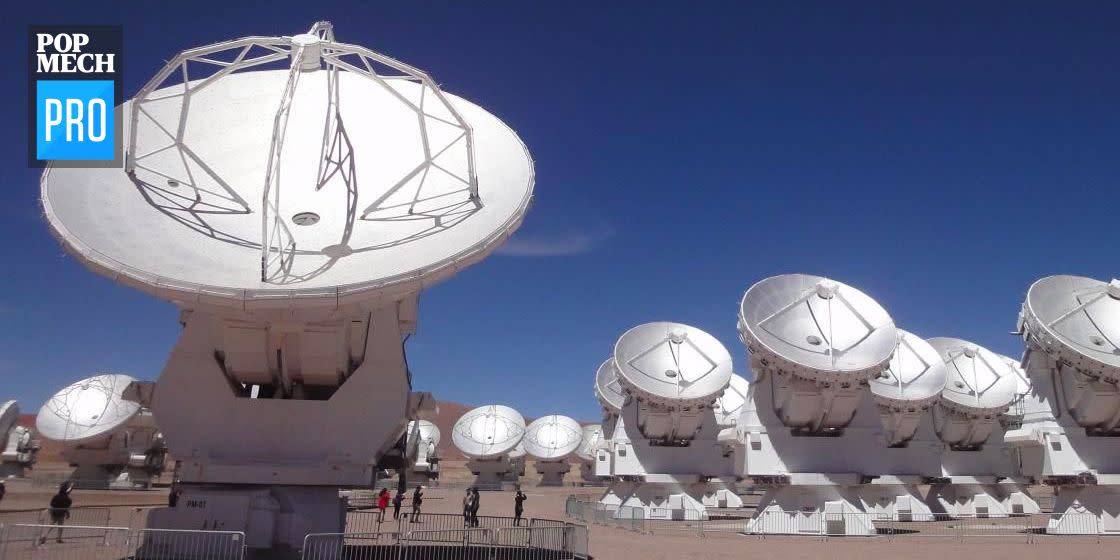Scientists Just Found 39 Ancient Galaxies

Using cutting-edge telescopes, scientists have observed 39 ancient galaxies.
These galaxies have become more difficult to find as the universe has aged.
Discovering the galaxies is just the beginning of the research.
Combining the strength of various observatories spanning the globe and off-planet space telescopes, scientists have discovered 39 previously unknown ancient massive galaxies, as well as the revelation that billions of years ago, these galaxies were intimately connected through supermassive black holes.
"This is the first time that such a large population of massive galaxies was confirmed during the first 2 billion years of the 13.7-billion-year life of the universe. These were previously invisible to us," says researcher Tao Wang of the University of Tokyo, who was involved with the study, in a press statement. "This finding contravenes current models for that period of cosmic evolution and will help to add some details, which have been missing until now."
Although telescopes like the Hubble have garnered fame for their startling images and discoveries, the Hubble has aged, and newer telescopes have helped to unveil images it could have missed. For Wang's team, that meant looking at the Atacama Large Millimeter/submillimeter Array (ALMA) based in the Chilean Andes.
The ALMA is designed to "study light from some of the coldest objects in the Universe," according to its website. Its 66 high-precision antennas, 54 of them with 39.3-foot diameter dishes and 12 with 22.9-foot diameter dishes, make it the the largest ground-based astronomical project in the world.
At one points, billions of years ago, the galaxies being studied by the scientists were the largest in the universe. Light emanating from them was especially weak, considering their age. As the universe grows older it expands, and as it expands, the light passing through the universe becomes stretched. Eventually, visible light becomes so long that it grows invisible to the human eye, in the form of what's known as infrared light.
In addition to the weaker light, astronomers also had to battle dust that has come to obscure their view of the far-off galaxies.
"It was tough to convince our peers these galaxies were as old as we suspected them to be. Our initial suspicions about their existence came from the Spitzer Space Telescope's infrared data," says Wang. "But ALMA has sharp eyes and revealed details at submillimeter wavelengths, the best wavelength to peer through dust present in the early universe. Even so, it took further data from the imaginatively named Very Large Telescope in Chile to really prove we were seeing ancient massive galaxies where none had been seen before."
Like the ALMA, the Very Large Telescope is managed by the European Southern Observatory, which is a 16-nation intergovernmental research organization dedicated to ground-based astronomy. Called the "world's most advanced optical instrument" on its website, the VLT is not one, but actually four Unit Telescopes with main mirrors 29.2 feet in diameter and four movable Auxiliary Telescopes with diameters of 5.9 feet.
"The more massive a galaxy, the more massive the supermassive black hole at its heart. So the study of these galaxies and their evolution will tell us more about the evolution of supermassive black holes, too," says Professor Kotaro Kohno. "Massive galaxies are also intimately connected with the distribution of invisible dark matter. This plays a role in shaping the structure and distribution of galaxies. Theoretical researchers will need to update their theories now."
Life in these galaxies would look radically different than it does in our current solar system.
"For one thing, the night sky would appear far more majestic," says Wang. "The greater density of stars means there would be many more stars close by appearing larger and brighter. But conversely, the large amount of dust means farther-away stars would be far less visible, so the background to these bright close stars might be a vast dark void."
There's still a lot left to learn about these 39 galaxies.
"These gargantuan galaxies are invisible in optical wavelengths so it's extremely hard to do spectroscopy, a way to investigate stellar populations and chemical composition of galaxies," Wang says. "LMA is not good at this and we need something more. I'm eager for upcoming observatories like the space-based James Webb Space Telescope to show us what these primordial beasts are really made of."
Many are excited for the James Webb, which hopes to replace the Hubble in the coming years. However, multiple mistakes in construction have delayed its launch date. Recently, Sen. Mike Enzi (R-Wyo.), chairman of the Senate Budget Committee, sent a letter to NASA Administrator James Bridenstine saying he was “troubled by continued reports” of the cost and scheduling issues with agency programs, highlighting the James Webb.
You Might Also Like

